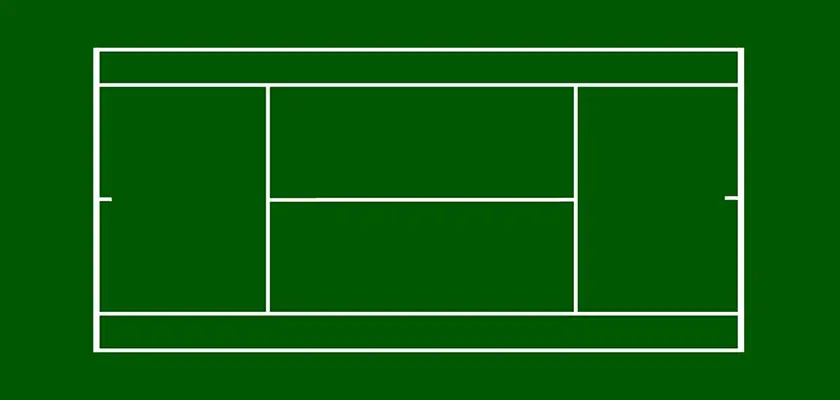Tennis, a passionate game full of strategic nuances, is governed by a set of rules – just like any other sport.
From the scoring of points to the dimensions of the court, the sport has guidelines that must be followed in any type of championship. These principles ensure the integrity and fairness of the matches.
In this complete and up-to-date guide, we’ll introduce you to the main tennis rules, such as the scoring system, how sets work, tie-breaks, permitted equipment and prohibited practices.
This way, you’ll understand the complexity of this sport that blends physical strength, endurance, technique, motor coordination and intelligence.
Check it out 👇
Tennis rules
- How does a tennis match work?
- Tennis court dimensions
- How are points counted in tennis?
- How many points are there in a tennis set?
- Tennis serve rules
- How do you score points in tennis?
- Tennis faults and offences
- Tennis penalties
- Electronic challenges in tennis
- Doubles tennis rules
- How do you change sides in tennis?
- Equipment allowed in tennis
How does a tennis match work?
Tennis is a sport that combines physical, mental and strategic skills. In its most traditional form, the game is played between two opponents or two doubles, each positioned on opposite sides of a rectangular court.
Right in the middle of the arena is a net. The main mechanic of the game, therefore, is to hit a small yellow ball into the opponent’s side. To do this, the athletes use a racket with strings on its surface.
Using the strength of their arms and the positioning of their legs, players perform a series of techniques with the aim of scoring points.
It’s worth remembering that the ball can only bounce once in the tennis player’s court before it’s passed to the other side again.
Matches are divided into sets. A player or team must win a predetermined number of sets to win the match.
Tennis court dimensions

The dimensions are standardised by the International Tennis Federation (ITF) and vary depending on whether the court is used for singles or doubles matches.
Singles courts are 8.23 metres wide by 23.7 metres long. Doubles courts are 10.9 metres wide by 23.7 metres long.
The court lines also have specific dimensions. The side lines are 5 centimetres wide, while the back lines are 10 centimetres wide.
The space between the singles line and the doubles line on each side of the court is known as the “alley” or “corridor” area. In singles matches, these areas are not used, but in doubles matches, they are part of the court.
These dimensions are applied internationally in official competitions, including Grand Slams (such as Wimbledon and the US Open).
Keeping these dimensions standardised is key to ensuring consistency and fairness in tennis matches around the world.
How are points counted in tennis?
Tennis matches are played in a best-of-three sets or best-of-five sets format (depending on the championship).
In the first case, whoever wins two sets first wins the match. In the second case, whoever wins three sets first wins the match.
A set is divided into games. Each game consists of points. The first player to win four points wins the game.
To win a set, a player must win six games with a lead of at least two games.
When the set is level at six games for each player, a tiebreak is played. In this tie-break, the player who reaches seven points first wins (as long as the score is two points apart).
How many points are there in a tennis set?
- Love: represents zero points;
- 15: the first point scored by a player;
- 30: the second point scored by a player;
- 40: the third point scored by a player;
- Deuce: when both players have a score of 40. From then on, one player must win two consecutive points to win the game;
- Advantage: when a player wins the next point after the deuce, they have the advantage.
NOTE: When an athlete who was down wins the next point, the game returns to deuce. This dynamic goes on endlessly until someone wins two consecutive points and closes out the game.
Tennis serve rules

In tennis, the serve is the action that starts the point.
It must be played behind the back line of the court, between the sidelines and below waist level.
The player must keep at least one foot on the ground during the serve and cannot step forward until the ball is hit.
The serve must go in the opposite direction to the server. In other words, if the player has served from the right side of the court, the ball must go to the left side, where the opponent will be positioned.
Each tennis player is entitled to two serves per point. So if the first serve is missed, there is a second chance.
If both serves go wide, it’s considered a double fault, resulting in a point for the opponent.
If the player steps on the line when serving, he loses the serve. If the ball hits the net and lands in the opponent’s area, the player can repeat the serve without losing one of their chances (this action is called a let).
During a tennis match, the players alternate their serves every game. In other words, the player who started the set serving will serve again in games 3 and 5.
This rule doesn’t apply to tie-breaks. In the tie-break, the tennis players alternate serving every two games (with the exception of the first game, which is unique).
In other words: in the tie-break, the player who started by serving will serve again in games 3, 4, 7, 8 and so on.
NOTE: when a tennis player who is not serving wins the game, we say that he has “broken” his opponent’s serve.
How do you score points in tennis?
- When the ball is hit into the opponent’s bounds and he can’t send it back out to the other side;
- When the opponent hits the ball out of the court;
- When the opponent hits the ball into the net and it fails to pass to the other side;
- When the opponent misses two serves in a row.
Tennis faults and offences
- Foot faul: during the serve, if a player touches or crosses the baseline with their feet before hitting the ball, it is considered a fault. The tennis player then loses one of their serves;
- Illegal serve: if the ball is not thrown up properly before the serve, or if the player tries to deceive the opponent by throwing the ball improperly, this can result in a fault. The tennis player then loses one of their serves;
- Double fault: when the tennis player misses two serves in succession, the point goes to the opponent;
- Touching the net: if the racket or any part of the tennis player touches the net during a point, the point goes to the opponent;
- Touching the ball: if the player touches the ball with any part of their body during a point, even unintentionally, the point goes to their opponent.
Tennis penalties

The match referee can issue warnings to tennis players for unsportsmanlike actions, such as arguing with judges, taking more than 25 seconds to serve, breaking rackets, swearing at their opponent or distracting their opponent on purpose by using deliberate movements or sounds.
If an athlete receives two warnings during a match, they lose the point they are playing for. In the case of a third, they lose the game. A fourth warning results in automatic defeat in the match.
Electronic challenges in tennis
Some tournaments allow players to challenge refereeing decisions using electronic review. They have a limited number of requests, which varies from championship to championship.
Doubles tennis rules
The rules for singles also apply to doubles.
The only difference is that in doubles, the sides of the court (which are considered “out” in singles) are valid in doubles. This means that the tennis players have more space to score.
How do you change sides in tennis?
The tennis players switch sides every game and at the end of each set.
Equipment allowed in tennis
- Racquet: fundamental to the game, tennis racquets come in different sizes, weights and string patterns. This is how players hit the ball;
- Tennis shoes: special shoes for playing the sport. There are appropriate models for each type of court;
- Clothing: shorts, skirts, short-sleeved T-shirts, polo shirts, tank tops and tank tops are permitted. It is up to the players to choose the most comfortable clothing;
- Accessories: players can use extra equipment, such as caps, visors, wristbands, knee pads and ankle pads, to protect themselves from the sun or to firm up injured parts of the body.
Now you know the main rules of tennis and are ready to watch matches without getting lost. Did you like this content? Let us know in the comments! Your feedback is very important to us 👊
Keep visiting our site every day for more complete and up-to-date texts on sports, games, betting and lotteries!





